INTRODUCTION
The Crystal Palace, also known as the Panoptichron, is a transdimensional observatory. It is located outside of space and time, overlooking every parallel reality in the multiverse. The origins of the Panoptichron are as mysterious as they are complicated. While seemingly somehow connected to or composed of the M’Kraan crystal, Kang the Conqueror claimed that it is not really a place, but the best interpretation our minds can make of the eye of time. Regardless of its shaky origins, it is the place a rag-tag group of reality-jumping heroes known as the Exiles call home.
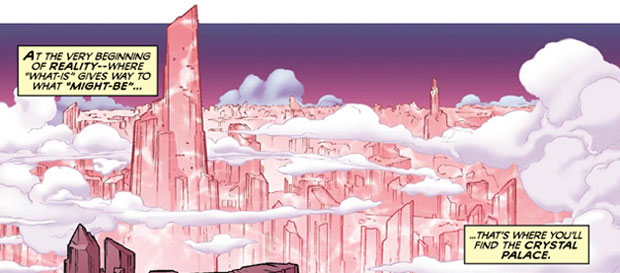
First Appearance: Exiles (1st series) #1 (Desert Room), Exiles (1st series) #61 (Crystal Palace)
Exiles Base of Operations: Exiles (1st series) #66
ETYMOLOGY
The Crystal Palace’s name seems to be an homage to the concept of the Panopticon. The Panopticon was an idea formed for prisons by Jeremy Bentham in the 18th century. The concept of the Pan(all) opticon(observing) was that one single centrally located guard would be able to observe all the inmates without them being able to tell whether they are being watched or not. The circular construct of the prison would allow the guard to position him or herself in a tower in the center of the prison. The term Panopticon itself also stems from Panoptes, a giant in Greek Mythology with a hundred eyes. Fittingly, "optichron" refers to the crystal nature of the palace and that, as the nexus of the multiverse, it can observe through time and space.
BACKGROUND
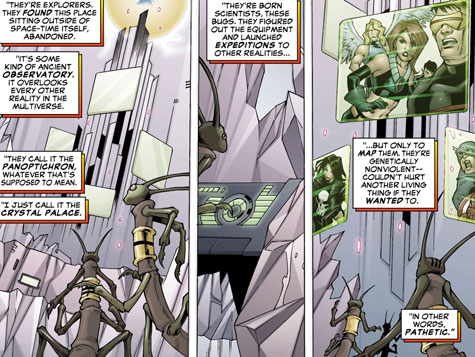 It is unknown at what point in time the Crystal Palace was built and who or what created it. It also remains unclear as to why the palace was abandoned — whether its creator(s) left it on their own accord, perished or were forced out.
It is unknown at what point in time the Crystal Palace was built and who or what created it. It also remains unclear as to why the palace was abandoned — whether its creator(s) left it on their own accord, perished or were forced out.
At some point in time, an alien insectoid race stumbled upon the Panoptichron; whether it was happenstance or it was their mission to find the palace remains unknown. They were natural scientists and managed to figure out that the palace was an observatory overlooking all realities. They launched expeditions to other realities, not really fully comprehending what they were dealing with, and in doing so ended up breaking time. They realized that, to repair the damage, they had to fix the broken chains of reality — a difficult task, one that these docile and peaceful creatures were unable of accomplishing on their own. These ‘time breakers’ decided that, to fix these realities, they would need to recruit a team of heroes to do their dirty work. [Exiles (1st series) #63]
CHRONOLOGY
The Timebreakers plucked six superheroes out of their respective native timelines and brought them to a room in the Panoptichron designed to appear to be a desert. There, they were informed that they had become unhinged in time due to ‘hiccups’ in time and, if they ever wished to return home, they needed to travel through the timestream completing missions until their respective timeline was repaired. 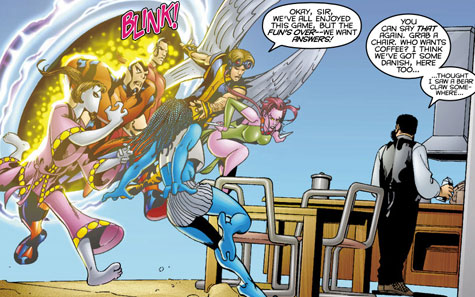 To communicate with these humanoid superheroes, the Timebreakers interfaced with them through a holographic construct they dubbed the Timebroker, which was explained to the heroes as being a creation of their collective subconscious. These exiles of their native timelines were equipped with the Tallus, a communication device informing them of their tasks and were sent on their mission. [Exiles (1st series) #1]
To communicate with these humanoid superheroes, the Timebreakers interfaced with them through a holographic construct they dubbed the Timebroker, which was explained to the heroes as being a creation of their collective subconscious. These exiles of their native timelines were equipped with the Tallus, a communication device informing them of their tasks and were sent on their mission. [Exiles (1st series) #1]
Realizing that some missions were more dangerous than others and might require some moral ambiguity, the Timebreakers recruited a second team of exiles. Most of this second team comprised of subjects of the Weapon-X program and so this team decided to call themselves Weapon-X.
The rosters of both teams were constantly changing, as there were casualties on both sides and some members, such as Blink, were seemingly returned to their native timeline after fixing their own respective reality. [Exiles (1st series) #22] This was all a lie, though, as the Timebreakers never intended to send any of the exiles back to their own timeline, and instead kept them in stasis within the Crystal Palace. They did the same with the deceased members of both teams as well.
The Timebreakers made their biggest mistake when they replaced a deceased member of Weapon-X with a maniacal version of Hyperion. Eventually, this unstable Hyperion — and all of his Weapon-X comrades — had to be put down. [Exiles (1st series) #43-45] Like they did with all of the deceased Exiles, the Timebreakers collected the corpses of the deceased Weapon-X members and put them in their stasis gallery within the Crystal Palace.  Unbeknownst to the Timebreakers, Hyperion had an incredible regenerative healing factor and soon broke out of the stasis wall and took over the Panoptichron. [Exiles (1st series) #63, 55-57, 60]
Unbeknownst to the Timebreakers, Hyperion had an incredible regenerative healing factor and soon broke out of the stasis wall and took over the Panoptichron. [Exiles (1st series) #63, 55-57, 60]
Meanwhile, during a mission to the Age of Apocalypse, the Exiles decided they would no longer blindly do as they were told and decided to trace the source of the Timebroker through the Tallus and confront the man who controlled their fates. With the help of a scientist on this world and the M’Kraan Crystal, the Exiles teleported to the Timebroker’s world, the Crystal Palace. [Exiles (1st series) #63, 55-57, 59-61]
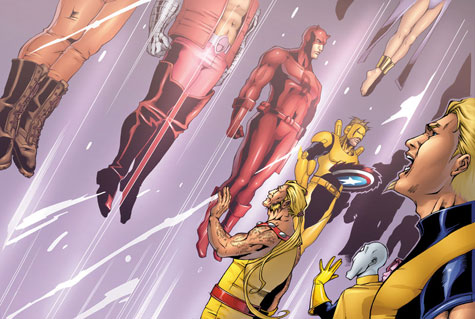 After exploring the Crystal Palace, the Exiles happened upon the stasis gallery, where all their former friends and teammates, along with the members of Weapon-X, were encased inside a crystal wall. They then found an insectoid worker drone, who led them to the control chamber, out of which the sovereign caste of the Timebreakers operated. The identity of the Timebroker was finally revealed to the Exiles but, before they could deal with the realization, Hyperion appeared before them and a fight broke out between them. In the ensuing battle, some members of the team were severely injured while others perished. In the end, they managed to defeat Hyperion and send him back to his native reality. [Exiles (1st series) #62-64]
After exploring the Crystal Palace, the Exiles happened upon the stasis gallery, where all their former friends and teammates, along with the members of Weapon-X, were encased inside a crystal wall. They then found an insectoid worker drone, who led them to the control chamber, out of which the sovereign caste of the Timebreakers operated. The identity of the Timebroker was finally revealed to the Exiles but, before they could deal with the realization, Hyperion appeared before them and a fight broke out between them. In the ensuing battle, some members of the team were severely injured while others perished. In the end, they managed to defeat Hyperion and send him back to his native reality. [Exiles (1st series) #62-64]
With the threat of Hyperion gone and the origins of their missions revealed, the Exiles took control of the Panoptichron from the Timebreakers, but allowed them to remain. The team soon made the Crystal Palace their base of operations. More importantly, they now had a home. After several missions, they returned their deceased comrades back to their friends and families on their own worlds. [Exiles (1st series) #83]
Heather Hudson chose to remain in the Crystal Palace instead of returning to her world and became the team’s new mission control. With her powers gone, she became an expert on how the Crystal Palace operated, thanks in part to the Timebreakers’ reluctant help. Although she did not join her fellow Exiles on their missions, she served as the team’s taskmaster, helping them as best as she could from the Panoptichron’s control room.
 Things looked bleak for the Exiles when they were unable to fulfill their mission on Earth-1720, and communications between Heather and the team was cut off as the entire dimension collapsed. As far as Heather could determine, her teammates were wiped out of existence. She could not cope with the news and decided the best course of her action was to return to her home and husband. Unbeknownst to her, the Exiles managed to survive their ordeal and returned to an abandoned Crystal Palace, which even the Timebreakers had vacated. [Exiles 1st series) #91-94]
Things looked bleak for the Exiles when they were unable to fulfill their mission on Earth-1720, and communications between Heather and the team was cut off as the entire dimension collapsed. As far as Heather could determine, her teammates were wiped out of existence. She could not cope with the news and decided the best course of her action was to return to her home and husband. Unbeknownst to her, the Exiles managed to survive their ordeal and returned to an abandoned Crystal Palace, which even the Timebreakers had vacated. [Exiles 1st series) #91-94]
The team went through some changes in its roster as some of its longer-standing members decided to retire, while others willingly joined the team or were mysteriously teleported to the Panoptichron. The Crystal Palace started behaving strangely as one such member, Kitty Pryde (or rather “Cat”), was mysteriously brought to the Panoptichron and seemed to have some strange connection with it. Exile team member Sage was amazed at how well Cat could operate the controls and realized she was somehow becoming integrated into the operational system of the palace. [Exiles (1st series) #96, X-Men – Die by the Sword, New Exiles #13]
Sage, who already felt assaulted by the countless entities she had absorbed into herself by way of the goddess Roma, took pity upon Cat and sent her on a mission with the Exiles while she battled her own personal demons and whatever else was trying to take over her new teammate. The Exiles returned to find that Sage had merged her own essence with that of the Crystal Palace. [New Exiles #18]
The Palace was not satisfied with just merging its core with Sage, though, and soon started merging with the rest of the Exiles as well. The palace managed to absorbe the entire active team, except for Morph, who managed to escape because had been possessed by Proteus at one point, who was absorbed in his place. Morph brought back his former teammates Blink, Nocturne and Heather Hudson and, together, they set out to continue their original mission. This time, however, they decided they would recruit multiple teams.
 The Palace finally awoke and asserted its consiousness in a crystalline form. The enormous figure appeared before the team. A female Kang the Conqueror emerged from its mouth and explained that meddling in time only fragments it and that the Crystal Palace was not a physical place. Kang further clarified that Exiles were never meant to go back to their realities, as doing so risks compromising the universe’s structure. Staying within the Crystal Palace for too long causes its inhabitants to join its structure and become a part of its collective consciousness. Thus, the team decided their best course of action was to draft multiple teams, each with an original Exiles member to help them transition into their new lifestyle. Kang gave each of the Exiles a Tallus, an extension of her essence that allowed them to avoid being absorbed into the palace again. [Exiles (2nd series) #1, 6]
The Palace finally awoke and asserted its consiousness in a crystalline form. The enormous figure appeared before the team. A female Kang the Conqueror emerged from its mouth and explained that meddling in time only fragments it and that the Crystal Palace was not a physical place. Kang further clarified that Exiles were never meant to go back to their realities, as doing so risks compromising the universe’s structure. Staying within the Crystal Palace for too long causes its inhabitants to join its structure and become a part of its collective consciousness. Thus, the team decided their best course of action was to draft multiple teams, each with an original Exiles member to help them transition into their new lifestyle. Kang gave each of the Exiles a Tallus, an extension of her essence that allowed them to avoid being absorbed into the palace again. [Exiles (2nd series) #1, 6]
FACILITIES
Since the Exiles assumed control of the Panoptichron, it has become more than their base of operations. The Crystal Palace has become their home, so naturally they have started assigning facilities and amenities.
Control Room
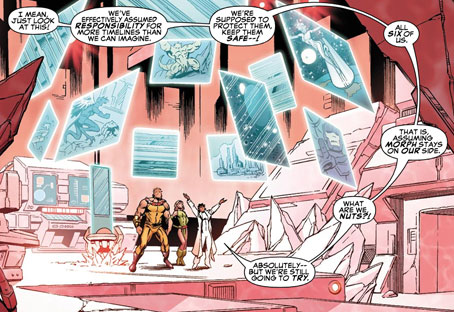 The team’s mission control operates from the Control Room. They have access to unlimited resources and can observe any and all realities in the multiverse. The interface known as the Timebroker is used out of this room and the team’s mission control watches the team’s progress and provides support out of this room.
The team’s mission control operates from the Control Room. They have access to unlimited resources and can observe any and all realities in the multiverse. The interface known as the Timebroker is used out of this room and the team’s mission control watches the team’s progress and provides support out of this room.
Stasis Gallery
 Not exactly a room but, while the Timebreakers still operated out of the Crystal Palace, they placed all former Exiles and Weapon-X team members into a stasis wall. It is unknown if the Timebreakers did this because they were aware that Exiles should not be returned to their native worlds or if they did this out of sentimental value. Regardless, once the Exiles assumed control of the Panoptichron, they returned all former Exiles to their respective home worlds.
Not exactly a room but, while the Timebreakers still operated out of the Crystal Palace, they placed all former Exiles and Weapon-X team members into a stasis wall. It is unknown if the Timebreakers did this because they were aware that Exiles should not be returned to their native worlds or if they did this out of sentimental value. Regardless, once the Exiles assumed control of the Panoptichron, they returned all former Exiles to their respective home worlds.
Beach Room
 The Panoptichron is so infinitely vast that the palace itself contains pocket dimensions within it that can be accessed through doors. One such room is the beach room, where the team enjoys hanging out on their downtime in between their missions. Some members relax on beach chairs while others enjoy surfing.
The Panoptichron is so infinitely vast that the palace itself contains pocket dimensions within it that can be accessed through doors. One such room is the beach room, where the team enjoys hanging out on their downtime in between their missions. Some members relax on beach chairs while others enjoy surfing.
Desert Room
Another such pocket dimension within the Panoptichron is the desert room. This room is where the original Exiles were first brought together when they were plucked out of their home worlds. This desert is vast and endless.

Ocean Room
Another pocket dimension room is the Ocean Room. Not unlike the beach room, it is unknown if this room contains any land or if it is an endless ocean. This room is where the Weapon-X team were first brought together when they were recruited.

Briefing Room
The briefing room is where the Exiles come together to discuss their plan of action or just to spend some time with one another. They even use this room as a dining area.

